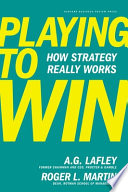

Choosing where to play involves identifying the markets, customer segments, and competitive arenas in which the organization will compete. This decision is critical because it shapes the organization's strategic focus and resource allocation. The authors argue that organizations must conduct thorough market analysis to understand the dynamics of different segments and select those that align with their strengths and aspirations. This choice also requires organizations to be selective, as trying to compete in too many areas can dilute efforts and lead to suboptimal performance. By clearly defining where to play, organizations can concentrate their efforts on the most promising opportunities.
Continue readingThe 'how to win' choice outlines the unique value proposition and competitive advantage that the organization will leverage in its chosen markets. This involves determining the strategies and tactics that will differentiate the organization from its competitors. The authors highlight the importance of understanding customer needs and preferences, as well as the competitive landscape, to develop effective strategies. Organizations must also be willing to innovate and adapt their approaches over time to maintain their competitive edge. A well-defined 'how to win' strategy not only guides operational decisions but also inspires employees to contribute to the organization's success.
Continue readingCore capabilities refer to the unique strengths and resources that an organization possesses, which enable it to execute its strategy effectively. The authors emphasize that organizations must identify and cultivate these capabilities to achieve their winning aspirations. This involves investing in talent, technology, processes, and partnerships that align with the chosen strategy. By focusing on core capabilities, organizations can build a sustainable competitive advantage that is difficult for competitors to replicate. The book encourages leaders to assess their current capabilities and make necessary adjustments to ensure alignment with strategic goals.
Continue readingThe book introduces a clear framework for developing strategy, which consists of five key choices that organizations must make. These choices include defining the winning aspiration, choosing where to play, determining how to win, identifying the core capabilities, and establishing the management systems. Each choice is interconnected and lays the foundation for a coherent strategy. By focusing on these choices, organizations can align their resources and efforts towards a common goal, ensuring that every team member understands the direction of the company. This framework simplifies the complex nature of strategic planning, allowing organizations to create actionable plans that lead to sustainable competitive advantage.
Continue readingA winning aspiration is the overarching goal of the organization. It defines what success looks like and provides a clear vision for the future. The authors emphasize that this aspiration should be ambitious yet achievable, motivating employees to strive for excellence. By articulating a clear winning aspiration, organizations can align their resources and strategies towards achieving this goal. This concept encourages leaders to think beyond mere profitability, focusing instead on creating value for customers, stakeholders, and society at large. A well-defined winning aspiration serves as a guiding star for decision-making and prioritization across the organization.
Continue readingThe final choice in the framework involves establishing management systems that support the execution of the strategy. This includes setting up processes for performance measurement, resource allocation, and decision-making that align with the strategic choices made by the organization. The authors stress the importance of creating a culture that supports strategic execution, where employees are empowered to take ownership of their roles in achieving the winning aspiration. Effective management systems ensure that the organization remains agile and responsive to changing market conditions, enabling it to adapt its strategy as needed.
Continue readingThe authors argue that strategy development is not a one-time event but an iterative process that requires ongoing assessment and adjustment. Organizations must continuously evaluate their external environment, internal capabilities, and performance outcomes to refine their strategy over time. This approach encourages a culture of learning and adaptability, where leaders and teams are open to feedback and willing to pivot when necessary. By embracing an iterative process, organizations can stay relevant in a rapidly changing business landscape and ensure long-term success.
Continue reading